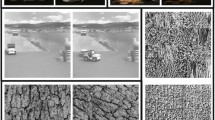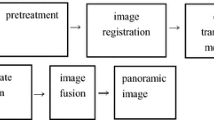Abstract
Feature detection is the basis of many computer vision applications. However, the existing feature detectors have poor illumination robustness for various reasons. FAST is a very effective detection method, and is currently widely used for real-time feature detection. The threshold function in the traditional FAST method is a linear function and is unable to deal with the issue of illumination robustness. This paper proposes an illumination-robust feature detection method, the core is an adaptive threshold FAST. The proposed method constructs a threshold function based on neighborhood standard deviation, which successfully solves the problem that the traditional FAST has poor illumination robustness. In addition, a new image preprocessing method consisting of homomorphic filtering and histogram equalization is introduced to the front-end of the proposed method in order to improve the quality of the input image. Compared with state-of-the-art methods, the repeatibility rate of proposed method has been increased several times in the underexposure matching experiment, and the number of repeated features has been increased by dozens of times. Meanwhile, the number of repeated features increased by more than a third on average in the overexposed experiment. The experimental results strongly prove that the proposed method has significant advantages in terms of repeatibility rate, number of repeated features and detection stability evaluation indices.












Similar content being viewed by others
References
Rashid M, Khan MA, Sharif M, Raza M, Sarfraz MM, Afza F (2019) Object detection and classification: a joint selection and fusion strategy of deep convolutional neural network and SIFT point features. Multimed Tools Appl 78:15751–15777. https://doi.org/10.1007/s11042-018-7031-0
Ma S, Bai X, Wang Y, Fang R (2019) Robust stereo visual-inertial odometry using nonlinear optimization. Sensors 17:3747. https://doi.org/10.3390/s19173747
Feng R, Du Q, Li X, Shen HF (2019) Robust registration for remote sensing images by combining and localizing feature-and area-based methods. ISPRS J Photogramm Remote Sens 151:15–26. https://doi.org/10.1016/j.isprsjprs.2019.03.002
Faille F (2004) A fast method to improve the stability of interest point detection under illumination changes. In: 2004 international conference on image processing, vol 4, pp 2673–2676 https://doi.org/10.1109/icip.2004.1421654
Gevrekci M, Gunturk BK (2009) Illumination robust interest point detection. Comput Vis Image Underst 113(4):565–571. https://doi.org/10.1016/j.cviu.2008.11.006
Harris CG, Stephens M (1988) A combined corner and edge detector. In: Alvey vision conference, vol 23, pp 1–6
Lowe DG (1999) Object recognition from local scale-invariant features. In: Proceedings of the seventh IEEE international conference on computer vision, vol 2, pp 1150–1157. https://doi.org/10.1109/ICCV.1999.790410
Bay H, Ess A, Tuytelaars T, Gool LV (2008) Speeded-up robust features (SURF). Comput Vis Image Underst 110(3):346–359. https://doi.org/10.1016/j.cviu.2007.09.014
Lee W, Chen H (2009) Histogram-based interest point detectors. In: 2009 IEEE conference on computer vision and pattern recognition, pp 1590–1596. https://doi.org/10.1109/CVPR.2009.5206521
Miao Z, Jiang X (2013) Interest point detection using rank order LoG filter. Pattern Recogn 46(11):2890–2901. https://doi.org/10.1016/j.patcog.2013.03.024
Wu S, Xu W, Jiang J, Qiu Y, Zeng L (2015) A robust method for aligning large-photometric-variation and noisy images. In: 2015 IEEE 17th international workshop on multimedia signal processing, pp 1–6. https://doi.org/10.1109/mmsp.2015.7340833
Hong-Phuoc T, Guan L (2020) A novel key-point detector based on sparse coding. IEEE Trans Image Process 29:747–756. https://doi.org/10.1109/TIP.2019.2934891
Verdie Y, Yi K, Fua P, Lepetit V (2015) Tilde: a temporally invariant learned detector. In: 2015 IEEE conference on computer vision and pattern recognition, pp 5279–5288. https://doi.org/10.1109/CVPR.2015.7299165
Yi KM, Trulls E, Lepetit V, Fua P (2016) Lift: learned invariant feature transform. In: European conference on computer vision, pp 467–483. https://doi.org/10.1007/978-3-319-46466-4_28
Savinov N, Seki A, Ladicky L, Pollefeys M (2017) Quad-networks: unsupervised learning to rank for interest point detection. In: 2017 IEEE conference on computer vision and pattern recognition, pp 3929–3937. https://doi.org/10.1109/CVPR.2017.418
DeTone D, Malisiewicz T, Rabinovich A (2018) Superpoint: self-supervised interest point detection and description. In: 2018 IEEE/CVF conference on computer vision and pattern recognition workshops, pp 224–236. https://doi.org/10.1109/CVPRW.2018.00060
Ono Y, Trulls E, Fua P, Yi KM (2018) LF-Net: learning local features from images. In: NeurIPS2018, pp 6234–6244
Dusmanu M, Rocco I, Pajdla T, Pollefeys M, Sivic J, Torii A, Sattler T (2019) D2-Net: a trainable CNN for joint description and detection of local features. In: 2019 IEEE/CVF conference on computer vision and pattern recognition, pp 8084–8093. https://doi.org/10.1109/CVPR.2019.00828
Rosten E, Porter R, Drummond T (2010) Faster and better: a machine learning approach to corner detection. IEEE Trans Pattern Anal Mach Intell 32(1):105–119. https://doi.org/10.1109/TPAMI.2008.275
Mair E, Hager GD, Burschka D, Suppa M, Hirzinger G (2010) Adaptive and generic corner detection based on the accelerated segment test. ECCV 2010:6312. https://doi.org/10.1007/978-3-642-15552-9_14
Leutenegger S, Chli M, Siegwart RY (2011) BRISK: binary robust invariant scalable keypoints. In: 2011 international conference on computer vision, pp 2548–2555. https://doi.org/10.1109/ICCV.2011.6126542
Rublee E, Rabaud V, Konolige K, Bradski G (2011) ORB: an efficient alternative to SIFT or SURF. In: 2011 international conference on computer vision, pp 2564–2571. https://doi.org/10.1109/ICCV.2011.6126544
Yao J, Zhang P, Wang Y, Luo Z, Ren X (2019) An adaptive uniform distribution ORB based on improved quadtree. IEEE Access 7:143471–143478. https://doi.org/10.1109/ACCESS.2019.2940995
Shahamat H, Pouyan AA (2014) Face recognition under large illumination variations using homomorphic filtering in spatial domain. J Vis Commun Image Represent 25(5):970–977. https://doi.org/10.1016/j.jvcir.2014.02.007
Shi J, Tomasi (1994) Good features to track. In: 1994 Proceedings of IEEE conference on computer vision and pattern recognition, pp 593–600. https://doi.org/10.1109/CVPR.1994.323794
Alcantarilla PF, Solutions T (2011) Fast explicit diffusion for accelerated features in nonlinear scale spaces. IEEE Trans Pattern Anal Mach Intell 34(7):1281–1298. https://doi.org/10.5244/C.27.13
Schmid C, Mohr R, Bauckhage C (2000) Evaluation of interest point detectors. Int J Comput Vision 37(2):151–172. https://doi.org/10.1023/A:1008199403446
Brown CE (1998) Coefficient of variation. Applied multivariate statistics in geohydrology and related sciences. Springer, Berlin. https://doi.org/10.1007/978-3-642-80328-4_13
Funding
This work was supported by the National Natural Science Foundation of China (Grant No. 61775172).
Author information
Authors and Affiliations
Corresponding authors
Ethics declarations
Conflict of interest
The authors declare that there is no conflict of interests.
Additional information
Publisher's Note
Springer Nature remains neutral with regard to jurisdictional claims in published maps and institutional affiliations.
Rights and permissions
About this article
Cite this article
Wang, R., Zeng, L., Wu, S. et al. Illumination-robust feature detection based on adaptive threshold function. Computing 105, 657–674 (2023). https://doi.org/10.1007/s00607-020-00868-9
Received:
Accepted:
Published:
Issue Date:
DOI: https://doi.org/10.1007/s00607-020-00868-9
Keywords
- Neighborhood information
- Adaptive threshold
- Feature point detection
- Illumination robustness
- Image processing




